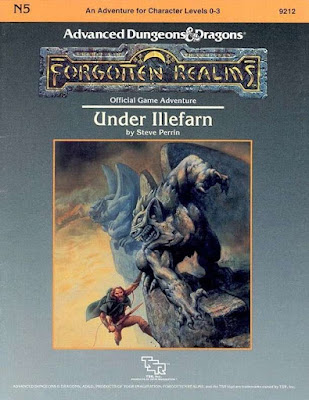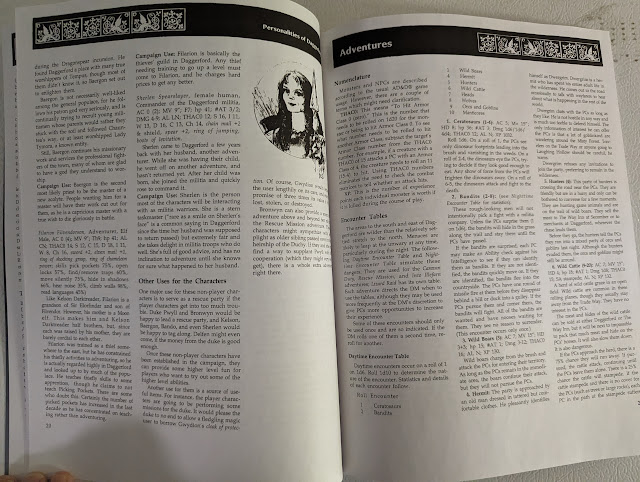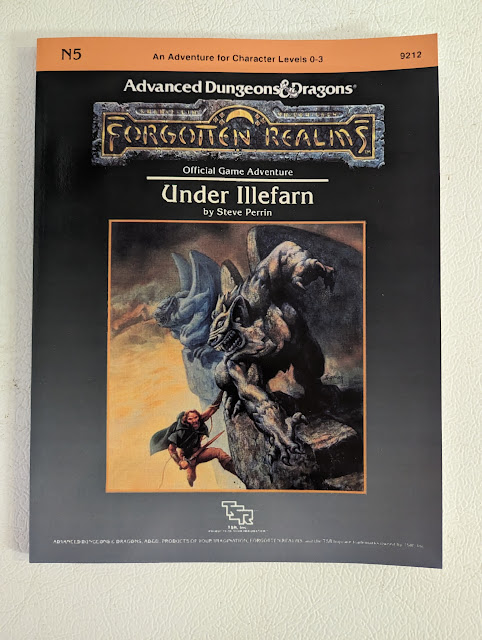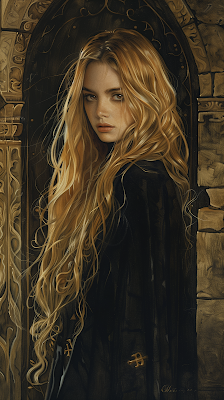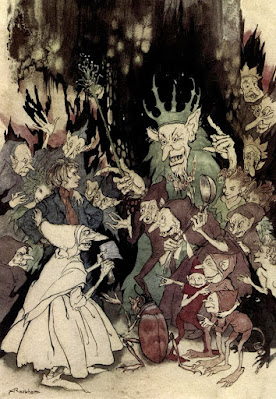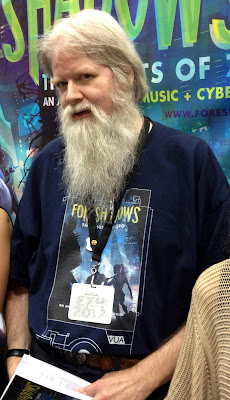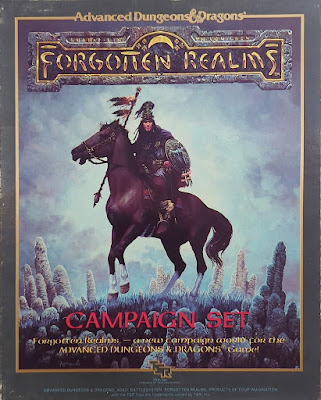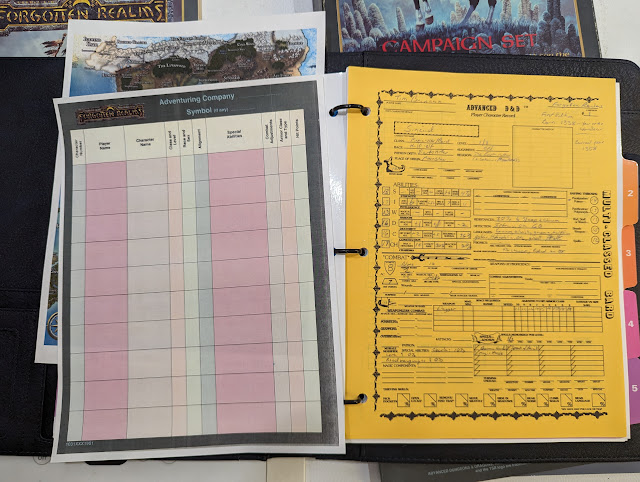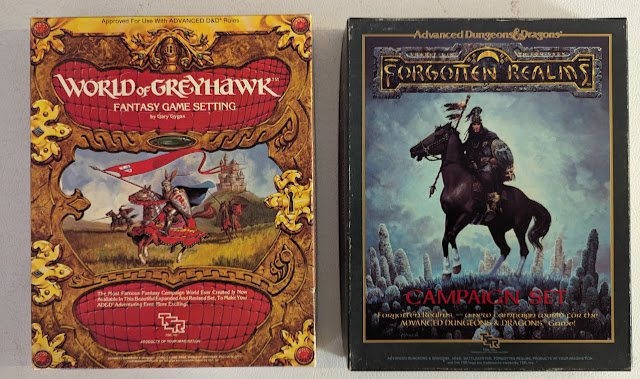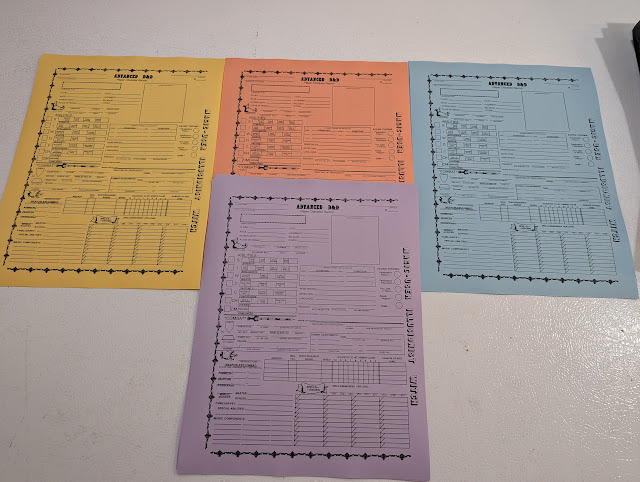1974 is an important year for the gaming hobby. It is the year that Dungeons & Dragons was introduced, the original RPG from which all other RPGs would ultimately be derived and the original RPG from which so many computer games would draw for their inspiration. It is fitting that the current owner of the game,
Wizards of the Coast, released the new version,
Dungeons & Dragons, Fifth Edition, in the year of the game’s fortieth anniversary. To celebrate this, Reviews from R’lyeh will be running a series of reviews from the hobby’s anniversary years, thus there will be reviews from 1974, from 1984, from 1994, and from 2004—the thirtieth, twentieth, and tenth anniversaries of the titles. These will be retrospectives, in each case an opportunity to re-appraise interesting titles and true classics decades on from the year of their original release.
—oOo—

It is interesting to note that two of the hobby’s mostly highly regarded humour roleplaying games were co-designed by Greg Costikyan and both were published in 1984. One, the dystopian Science Fiction roleplaying game,
Paranoia, published by West End Games, was most obviously published in 1984, because after all, that was the year that George Orwell’s eponymous novel is set. The other was
Toon – The Cartoon Roleplaying Game. Published by Steve Jackson Games, it was based on an original idea by Jeff Dee which was inspired by a conversation about genres that nobody had then yet designed roleplaying games for. As its title suggested, that genre was cartoons. Not the cartoons of Saturday mornings, but rather the short, sometimes violently anarchic cartoons of Warner Bros’
Looney Toons, Hanna and Barbera’s
Tom and Jerry, and Walt Disney’s
Silly Symphonies and others. This is a genre that almost everyone is familiar with, making the resulting roleplaying game incredibly familiar in terms of what you were playing and the world in which it took place. However,
Toon also asked a great deal of its players in terms of how it was played, because in many ways it was asking them to do everything which other roleplaying games had taught them to do.
In almost every other roleplaying game, the player not only wants his character to survive, to grow, and to thrive, which invariably means plotting and planning, and taking the time to come up with the best tactics or strategy to achieve all three. Not so in
Toon. Let alone the fact that a character in
Toon cannot die—only fall down for three minutes of real time—the play is all about the immediate. What does my character want? How does he achieve that right now? What is the simplest and more direct way of getting that? It does not matter if that direct way is not the most logical, for it serves its purpose right now. So rather than ‘think before you act’, the credo of
Toon is ‘ACT before you THINK’. The roleplaying game will even punish a player if he thinks before he acts or attempts to think before he acts, rendering his character Boggled and unable to do anything until his next turn. This is a roleplaying game played at high speed, even breakneck speed, in which the action passes from one character to the next in a flurry, in which Short Subjects and Feature Films always take place in Anytown, Outside of Town, The City, and Outer Space, where there is always a mailbox close by to receive that thing you just ordered, logic has a way of being illogical in an entirely logical way, coincidences are perfectly normal and to be expected, cause and effect might go one way for a character, but not another, and nobody reads the fine print until you write it and persuade everyone as to its veracity.
Toon – The Cartoon Roleplaying Game is a roleplaying game with a genre that everyone will know and will understand how its worlds work, supported by simple, fast-playing mechanics, good advice for the Animator—as the Game Master is known, and four Short Subjects and one Feature Film. One of the Short Subjects is designed to teach the game and so with a quick read through and copies of the characters ready, the Animator really could be running her first game in fifteen minutes.
A character can be anything. An ant, a robot ant, a sea serpent, a kangaroo, a pig, a parakeet, and so on. He can run and talk, take part in the Cartoon Olympics, go to Outer Space, and more, whether he is a Milkman, a Retired General, a French Chef, or a Cowboy. He has four attributes—Muscle, Zip, Smarts, and Chutzpah—which determine how strong, how fast, how intelligent, and how pushy he is. They are range in value between one and six. Each attribute has a number of skills, which range in value between one and nine. He will have a natural enemy, such as a cat for a dog or a park ranger for a bear; a Belief and a Goal, for example, “I hate elephants” and “Stop the hunter from hunting me in Rabbit Season”; a possession or two; and Shtick. A Shtick is an amazing ability that breaks rules. For example, a Bag of Many Things from which innumerable objects can be drawn, Shape Change, Hypnosis, and so on. Mechanically, they are rolled for just like skills to see if they work.
To create a character, a player rolls a six-sided die for each of the four attributes. Species, Occupations, Beliefs, and Goals can selected or rolled for, or selected, whilst Natural Enemies are always chosen. The base value for each skill is equal to its associated attributes, but a player has thirty points to divide between them. Alternatively, a character can have a Shtick, which costs five skill points and always begins play with a value of five. This cannot be increased during character creation, only later through experience. The process is quick and easy and takes five minutes.
Doctor Freuderick “It’s pronounced ‘Frederick’” von Mesenme (Actually Joe from Pittsburgh)
Species: Human
Natural Enemies: Patients and other doctors
Belief: I always know what is best for my patients
Goal: Get rich
Hit Points: 9
Muscle 3
Break Down Doors 3, Climb 3, Fight 6, Pick Up heavy Things 3, Throw 3
Zip 2
Dodge 7, Drive Vehicle 2, Fire Gun 2, Jump 4, Ride 2, Run 4, Swim 4
Smarts 5
Hide/Spot Hidden 5, Identify Dangerous Thing 7, Read 5, Resist Fast Talk 8, See/Hear/Smell 5, Set/Disarm Trap 5, Track/Cover Tracks 5
Chutzpah 6
Fast-Talk 9, Pass/Detect Shoddy Goods 9, Sleight of Hand 6, Sneak 6
Shticks
Hypnosis 5
Possessions
Medical Diploma from The Republic of Užupis University of Universal Study, Pocket Watch, Pipe (for bubbles), medical forms
Mechanically,
Toon is simple. To undertake an action, the player rolls two six-sided dice, and aims to roll equal to or lower than the skill or attribute. It is a simple yes or no mechanic. Situations where there is an opposed roll, such as a fight or a chase or a competition, the outcome is determined by who rolls successfully and who fails. Thus, in a chase, the character who makes a successful roll with either Drive Vehicle, Run, or Swim will get away from the character who fails his roll, whereas if both make a successful roll or fail, neither makes any progress. Combat uses the Fight or Shoot Gun skills, with brawls and bust ups being opposed rolls. In general, if neither side is successful, that is, makes a successful roll whilst the other fails, then after three rounds of both making successful or failed rolls, both characters fall down exhausted. If a character is successfully hit in a fight or shot, then he suffers a six-sided die’s worth of damage. If he loses all of his Hit Points, the character will Fall Down. This is bad, but not actually that bad, because unlike every other roleplaying game, the character is not dead. Instead, he is out for the count, but can bound back, because that count is three minutes of real time. After that, the character and his player are back in the game with full Hit Points, ready to play.
The mechanical aim of play is to earn Plot Points. These actually reflect how well a player has roleplayed his character and served the genre of the Short Subject or the Feature Film. Each Short Subject and Feature Film has a budget to divide amongst the Player Characters at the end, but a player can earn more when his character makes another Fall Down, roleplays the character’s Beliefs & Goals, has his character make a Natural Enemy Fall Down, roleplays his character in a clever or entertaining fashion, and even for making the Animator laugh. Conversely, he loses them if he does not roleplay the character’s Beliefs & Goals or if the character is made to Fall Down by an NPC. Plot Points are used to increase a Player Character’s skills and shticks, including buying new shticks.
In terms of game play,
Toon – The Cartoon Roleplaying Game begins before Player Character creation. This gives a description the base elements of the game, how the skills work, a quick introduction to Plot Points, and some advice the Animator. All this in preparation for ‘The Cartoon Olympics’, a Short Subject designed for the Animator and two players. Taking place in the Anytown Anydome, this sports event will see the Player Characters compete in boxing matches, javelin toss, and marathon to determine the winner. They will also have to deal with Judge Mole, who of course, is blind as and also armed with a deadly starting pistol, and a bunch of monkeys. Although intended for two platers, the Short Subject includes a quartet of potential Player Characters, such as Mack the Mouse, Olga Hippopovna, Fred Bulldog, and Fifi La Feline. This is an easy to prepare Short Subject that can be brought to the table very quickly.
It should be noted that
Toon also emphasises adversarial play, a feature also shared with
Paranoia. Player Characters can have conflicting goals even as they work collectively towards the objective of a Short Subject or Feature Film, but more often than not, they are directing competing against each other, as in ‘The Cartoon Olympics’, and unlike in other roleplaying games, there can be a winner. Offset that though, with the fact that
Toon is designed for ephemeral, one-shot play rather than campaigns, so even if the same Player Characters appear in a subsequent Short Subject or Feature Film, the events or outcome of a previous Short Subject or Feature Film will not have any real influence on the next one.
Beyond both ‘The Cartoon Olympics’ and Player Character creation,
Toon – The Cartoon Roleplaying Game explains how Beliefs & Goals, skills, and shticks all work, plus there is good advice on being the Animator. Ultimately, this boils down to keeping things moving, throwing in sound effects, playing to the genre, and transmitting the right atmosphere to her players. The advice also stresses that the most important aspect of being an Animator is to remember that the Animator is in charge, and that anything she says goes. That said, the Animator should always be open to ideas from her players and when it counts, she should act crazy.
Rounding out
Toon – The Cartoon Roleplaying Game are another three Short Subjects and one Feature Film. The extra Short Subjects include ‘The Cartoon Olympics Strikes Back!’, which really just expands on ‘The Cartoon Olympics’ with a single page; ‘I Foogled You!’ sends the Player Characters into the jungles of Darkest Africa (conveniently located Outside of Town) in search of the famed Foogle Bird, which involves lots of swinging on vines with a Tarzan-like character and his wife; and ‘Spaced Out Saps’ in which members if the Space Aeronautics Patrol Squad or S.A.P.S., take a trip to the Moon (conveniently located Outside of Town) and investigate strange activity involving The Martian and The Martian Dog. The Feature Film is ‘The Better Housetrap’ in which the Player Characters are trying to hide out in a newly built house, only for them to discover that the house is actually robotic! Each one of the Short Subjects and the Feature Films can be played in a single session and each wears its inspirations firmly on its sleeves.
Physically,
Toon – The Cartoon Roleplaying Game is cleanly, tidily laid out and organised. It is liberally illustrated with entertaining cartoon artwork. The roleplaying game is well written and easy to read and grasp.
—oOo—
Toon – The Cartoon Roleplaying Game was reviewed not once, but twice by
Dragon magazine. First by Michael Dobson in ‘New heights(?) in silliness’ in
Dragon #92 (December 1984), in which the opening line is, “TOON™, The Cartoon Roleplaying Game, appears at first glance to be just an elaborate joke.” before he qualifies this with, “…TOON is a genuine good idea – an original (if unlikely) concept in role-playing – that is enjoyable, fastmoving, and incredibly silly.” Although critical of the roleplaying game’s use of Plot Points, which he felt were, “…[A] holdover from traditional role-playing games that doesn’t quite fit the TOON spirit. In a straight adventure game, a character’s potential to improve may be important as a tool to motivate the player and to keep a campaign going. In TOON, this approach doesn’t make sense. Cartoon characters never get “better.”” Nevertheless, Dobson described
Toon as “Inspired silliness…” Jim Bambra would follow this up in
Dragon #144 (April 1989) in ‘Role-Playing Reviews’. He described it as “…[A] classic – a game which deserves the attention of everyone looking for a dramatic change of pace and emphasis in their role-playing.” before concluding with, “The TOON game provides an excellent change of pace and a shift of emphasis away from the more serious role-playing games. I highly recommend it as an evening’s entertainment and as a cure to role-playing blues.”
In ‘Notices’ in
Imagine No 21 (December 1984), Mike Lewis was equally as positive, concluding his review with, “Toon is a very refreshing change from the usual run-of-the-mill rpgs which have been appearing recently. The game very firmly puts a sense of humour back into rpgs. If you are interested in cartoons, then Toon is an essential purchase — but even if you aren’t, try it for a change. I am very impressed with the ideas behind this game and hope that it gets more support than most minority RPGs have done in the past. It deserves it.”
R.A. Greer reviewed
Toon in
Space Gamer Number 72 ((Jan/Feb 1985) and like Jim Bambra would four years later, described it as an antidote to the roleplaying blues, saying that, “TOON is a quick cure for all your roleplaying ills, a fast-acting balm to be applied directly to your funny bone, speeding you back to those uncomplicated days of roleplaying when it was fun!” His conclusion was equally as complimentary, stating that, “TOON is a gen for those willing to work with it a little bit. (The game should have been published with a qualified Animator stapled inside.) It may not replace the weekly fantasy game, but it’s great change of pace. It is also a great introduction to roleplaying for that new to the hobby and really allows experienced gamers to let down their hair. Almost all of TOON’s problems can be solved by applying this simple maxim: “If you want to do it, exaggerate it; if it’s simple, complicate it; if you’re in a jam, take all steps to make it worse.” Follow these simple rules and you’ll advance the plot and add to the fun. Congratulations to Steve Jackson Games on a job well done.”
None other than Larry DiTillio reviewed Toon in ‘Game Reviews’ in
Different Worlds Issue 38 (Jan/Feb 1985), awarding the roleplaying three stars out of four and praising its writing, stating that, “[Greg] Costikyan has clarity, wit, and the good sense to be brief, as well as an obvious love for cartoons. The rulebook not only reads quickly and easily, it makes you eager to play the game.” He advised that, “Role-players of a basically serious nature and gamemasters who prefer rigid detail are advised to stay away. On the other hand, for a few hours of silliness, Toon can’t be beat and is a refreshing change from the ofttimes leaden pace of other role-playing games. It’s fast, it’s fun, it’s simple.”
Lastly,
Toon was reviewed in ‘Open Box’ in
White Dwarf Number 63 (March 1985) by Stephen Kyle, who awarded it nine out of ten. He concluded that, “For anyone who likes cartoons, then Toon is definitely worth looking into. It concentrates more on the Warner Brothers/Hanna Barbera type of American cartoon, rather than the more sophisticated British product like Dangermouse. Nevertheless, all of us have favourite cartoons or characters and Toon enables you to recreate them easily and with a lot of fun. I just hope it gets more support than most minority RPGs.”—oOo—
Toon – The Cartoon Roleplaying Game does have one single problem—and it is a big one. That is the degree of buy-in that a Game Master and her players need to have to play and enjoy
Toon, the willingness to accept its implied anarchy and mandatory impulsiveness of ‘ACT before you THINK’, and to break the learned habits of playing roleplaying games. A player unwilling or unable to make that adjustment is not going to enjoy or appreciate the fun that
Toon has to offer.
Toon – The Cartoon Roleplaying Game is and was a groundbreaking roleplaying game, because of its treatment of the cartoon genre and its humour, although numerous roleplaying games have visited its genre since. It is simple, even simplistic, but the simplicity of the rules and the mechanics means that
Toon is incredibly easy to teach and just as easy to grasp, and when it comes to its genre,
Toon has the most accessible, most familiar genre of almost any roleplaying game. After all, who has not seen a Looney Tunes or Tom and Jerry cartoon? Which absolutely makes it great for convention play. That said, whilst it can be used as an introductory roleplaying game, it is not written as an introductory roleplaying game, so is best suited to be run by an experienced Game Master who can adapt to its fast pace and over the top, silly play. Similarly, this is a roleplaying game whose speed and tone is something that experienced players will also have to adapt to in order to get into the spirit of the roleplaying game and its silly, cartoon humour. Essentially, this is not a roleplaying game which the Game Master simply decides to run—her players have to buy into the whole concept, big anvil, stick of dynamite, and all.
Toon – The Cartoon Roleplaying Game is undemanding fun that in the hands of a good Animator awards energy, inventiveness, and impulsiveness.
Toon – The Cartoon Roleplaying Game is the roleplaying equivalent of a tonic, a great pick up and play roleplaying game that enables the players to engage in all of the mayhem and madness of their favourite childhood cartoons and after they Fall Down, get back up and dive right back in.
 Name: Monsieur Deloffre Has Gone Quite Mad!Publisher: Chaosium, Inc.
Name: Monsieur Deloffre Has Gone Quite Mad!Publisher: Chaosium, Inc.




